![]()
Heroin
The most notorious addictive opioid drug.
![]()
Paul May
University of Bristol, UK
and
Masoud Sadeghi
University of Kashan, Iran
![]()
Molecule of the Month March 2023
Also available: HTML version.
![]()

HeroinThe most notorious addictive opioid drug.
Paul May
Molecule of the Month March 2023
|
 |
Heroin? What a name!The head of the German chemical company Bayer's research department reputedly coined the drug's new name "heroin", based on the German heroisch which means "heroic, strong" (from the ancient Greek word "heros"). When was this?Surprisingly, not that long ago. Around 1900, morphine (see MOTM for November 2004) was a popular recreational drug and medical painkiller, but it was notoriously addictive. From 1898 through to 1910, diamorphine was marketed by Bayer under the trademark name Heroin as an over-the-counter non-addictive morphine substitute and cough suppressant. |
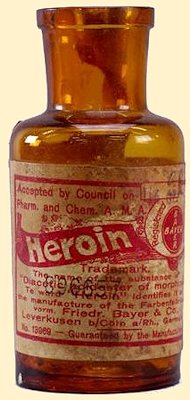 Bayer Heroin-hydrochloride bottle. [Image: DEA Museum, USA] |
Well, contrary to Bayer's advertising, heroin would soon have one of the highest rates of addiction among its consumers. In 1924, the United States Congress banned its sale, importation, or manufacture. It is now a Schedule I substance, which makes it illegal for non-medical use in signatory nations of the Single Convention on Narcotic Drugs treaty, including the United States. Despite this, current estimates are that around 0.3% of the US population is addicted to heroin as a result of recreational use!
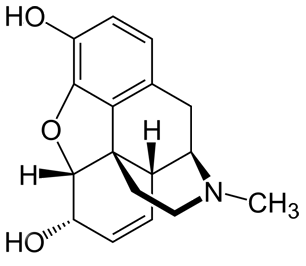 |
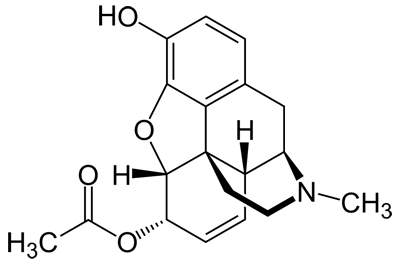 |
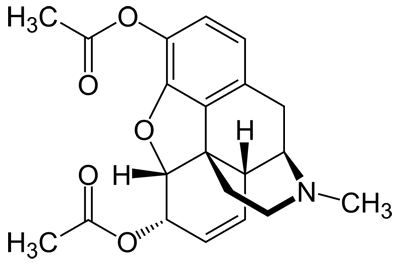 |
| Morphine | 6-Monoacetylmorphine | Heroin |
Heroin is an opioid painkiller and chemically very similar to morphine. Actually, heroin is a morphine molecule with two attached acetyl groups and that is why it is also known as diacetylmorphine or diamorphine.
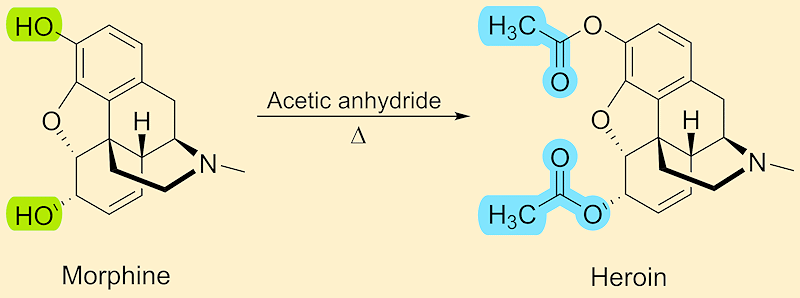
Morphine conversion to heroin.
Historically, Alder Wright, an English chemist at St. Mary's Hospital Medical School in London, synthesized heroin in 1874, through boiling the anhydrous morphine alkaloid with acetic anhydride for several hours. He was trying to react morphine with different acids to prepare a more potent painkiller.
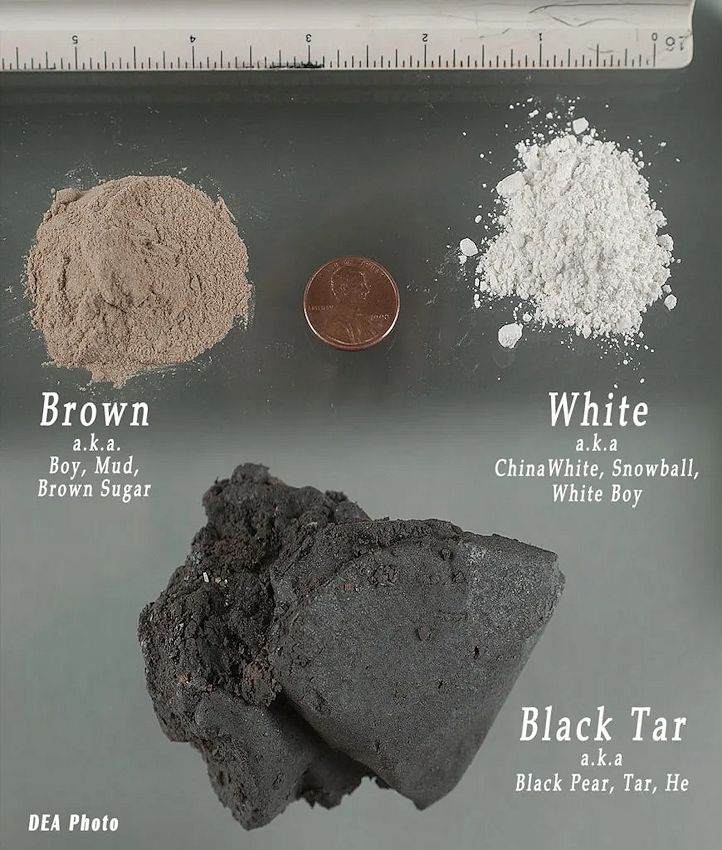
Different types of heroin. Brown heroin is the highly impure product of the acetylation reaction between morphine and acetic anhydride. Further purification steps produce white heroin. Black tar heroin is a very impure form that can be sticky like tar or hard like coal. Crude processing methods leave behind impurities, colouring it black, dark orange or dark brown.
[Image: Drug Enforcement Administration (DEA), USA.]
Heroin hydrochloride is approximately twice as potent as morphine sulfate, and acts slightly faster but for a shorter duration than morphine.
Internationally, it is generally illegal to manufacture, possess, or sell heroin without a license. In the United States, the government does not recognize any medical uses of heroin, and considers it highly addictive. In contrast, in the UK and many EU countries, heroin is often prescribed, especially in hospitals, under the generic name diamorphine as a strong pain medication which is administered via subcutaneous, intramuscular, intrathecal or intravenous routes. Heroin can also be prescribed as a cough suppressant or as an anti-diarrhea treatment, but only under medical supervision and usually in pill form since that does not come with an immediate euphoria ‘rush’, and spreads the effects over a longer period of time, making it less likely to lead to addiction.
The most common way to take heroin recreationally is by injection, though it can also be snorted or smoked. The reason for this is that when injected, 100% of the drug enters the bloodstream unchanged, whereas for other methods the ‘bioavailability’ comes down to 35-45%.
It depends upon how the heroin was taken. If it was snorted, it enters the bloodstream through the fine capillaries in the nose, and various metabolic processes then remove both acetyl groups from the molecule, reverting it back to morphine.
Chemically yes, but not in dosage. The concentration of morphine in the bloodstream after snorting heroin orally is about double the concentration as when ingesting oral morphine, so it is equivalent to taking a double dose of morphine.
 What about other methods?
What about other methods?Pure heroin is not soluble in water, so to make it injectable it needs to be mixed with an acid (usually citric acid powder or lemon juice) and heated, often in a spoon over a cigarette-lighter flame. The solution is then drawn up into a hypodermic needle, and the hot liquid injected into a suitable vein. Street heroin can also be obtained in its hydrochloride form, which is soluble in water and does not need to be heated. Injecting heroin is particularly dangerous, as addicts who share needles run the risk of contracting diseases such as hepatitus and HIV/AIDS. Also, repeated injections into the same vein often causes the vein to collapse or become infected, leading to addicts using less accessible veins which increases the chance of deep-vein thombosis - blood clots which can lead to death.
When injected, the unchanged molecule rapidly crosses the blood-brain barrier. A deacetylation reaction turns it into 6-monoacetylmorphine and then a second reaction into morphine. Because this happens in the brain, it is a very quick process, and users get an almost immediate euphoria rush.
There are various reasons, but the intense euphoria, or ‘rush’, is what most recreational users are looking for. It also dulls pain and anxiety, causing users to feel very relaxed. Often, for people with low incomes, living seemingly hopeless lives in inner-city slums, heroin was seen as a way to temporarily escape from reality. The rise in addicts (junkies) has reached near epidemic proportions in some cities, and the addicts' desperate need for money to fuel their addiction, turned them to crime, creating a drug-fuelled crime wave. Despite the US government’s so-called War on Drugs and the ‘Just say No’ campaign, addiction to drugs such as heroin remains a major problem in most countries.
There are significant adverse short and long term effects for heroin consumers. In the short term, the euphoric rush may be accompanied by nausea, vomiting, and severe itching. Users may be drowsy for several hours afterwards, with reduced mental capacity, a slower heart-beat and much slower breathing – which can lead to death by asphyxiation. Repeated use changes the physical structure and physiology of the brain, which loses the neuronal and hormonal balances that are not easily reversed, along with deterioration of the brain's white matter. The body may also build up a tolerance to heroin, such that increasingly higher dosages are required to obtain the same effect. Eventually, a physical dependence on heroin is built up, which means that withdrawal symptoms may occur of the drug is suddenly stopped.

A drug user suffers in plain sight in Garment District, New York. Common street names for heroin include: Big H, Black Tar, Chiva, Hell Dust, Horse, Negra, Smack, and Thunder.
[Image: Heroin, Drug Fact Sheet, Drug Enforcement Administration (DEA)]
Yes, cold turkey is when the drug is removed abruptly and the user forced to endure the withdrawal symptoms, rather than reducing the dosage slowly over time. The withdrawal symptoms from heroin can be quite severe, including sweating, anxiety attacks, depression, cold sweats, chills, severe muscle and bone aches, nausea, vomiting, diarrhea, cramps, and involuntary spasms in the limbs. The latter is believed to be the origin of the term "kicking the habit". But if the users do not eventually kick the habit, the outlook is bleak.
Yes. Because of the buid up of tolerance, a long-term user has to use larger and larger dosages, and eventually they often overdose. This can happen to new users too, especially those recreational users on the street who do not know the source of purity of the heroin they use, or the effects of combining heroin with other drugs such as alcohol or benzodiazepines.
Between 2012 and 2015, heroin was the leading cause of drug related deaths in the United States (a record that has since been overtaken by fentanyl (see MOTMs for March 2015) and Dec 2018). Death from heroin overdose usually occurs due to the user’s breathing slowing so much, and then stopping completely. Heroin can make the user vomit, so many deaths occur because the unconscious user chokes on their own vomit.

USA annual overdose deaths by heroin and other opioid involvement.
[Image: Overdose Death Rates, National Institute on Drug Abuse (NIDA)
Until the mid-2000’s, not much. But then a ‘miracle’ drug called Narcan (naloxone) (see MOTM for Nov 2018) was invented which can reverse the effects of heroin overdose almost instantly. One simple injection of this drug, and the effects of the opioid (heroin, cocaine or fentanyl-based drugs) are almost instantaneously neutralised, and often the patient recovers consciousness within a few minutes. Many emergency-service personnel and police officers in many countries now carry naloxone kits as standard, an these have already saved many thousands of people from death by overdose.
Heroin really hit the world consciousness following the Vietnam war in the 1970s. A US congressional report stated that ~15% of US servicemen in Vietnam were actively addicted to heroin at the time. The reason for this high rate was the easy availability, because Vietnam is adjacent to the The Golden Triangle - the three countries which comprised the largest heroin-producing region in the world at that time – Myanmar (Burma), Thailand, and Laos. This availability, combined with the soldiers’ wish to escape the horrors of war, led to widespread heroin use – and addiction. In the 19080s and 90s, heroin illegally imported in the US and Europe from many South American countries, such as Colombia, began homegrown heroin epidemics. Since 2001, Afghanistan has been the world's leading illicit drug producer since 2001. The Golden Crescent, comprising Afghanistan and some parts of Iran, produces more than 90% of all the illegal heroin globally, and more than 95% of the European supply.
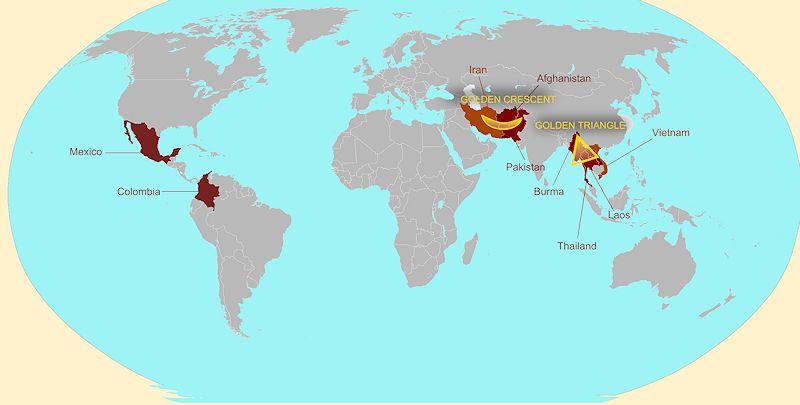
Primary worldwide producers of heroin 2021.
From the 1990s onwards, popular culture highlighted heroin use and drug culture. Some critics would go so far as to say it even ‘celebrated’ heroin usage, making it seem hip and trendy. This was apparent in a number of movies including Trainspotting and Pulp Fiction, as well as the rise of so-called ‘heroin chic’ – a fashion trend epitomised by pale, emaciated models with angular bone structure.
 |
 |
 |
| British supermodel Kate Moss in an advert for Calvin Klein in the 1990s epitomised so-called 'heroin chic'. |
Poster for the 1996 film Trainspotting about a group of Edinburgh heroin addicts. [Image: Wikipedia] |
Poster for the 1994 film Pulp Fiction. [Image: Wikipedia] |
Heroin use was also common among jazz musicians in the mid-20th century (including Billie Holiday, Charlie Parker and Ray Charles), and rock musicians from the 1960s onwards. These included Kurt Cobain, lead singer of Nirvana, Phil Anselmo (Pantera), Jimmy Page (Led Zeppelin), John Lennon (Beatles), Eric Clapton, Keith Richards (Rolling Stones) and Janis Joplin. Heroin (mis)use or withdrawal has inspired a surprising number of famous rock songs, including 'Golden Brown' by the Stranglers, 'Coming Down Again' by The Rolling Stones, and 'Givin’ Up' by The Darkness.

10 celebrities who have spoken openly about their experiences with heroin. From top left: Philip Seymour Hoffman (actor), Russell Brand (English comedian and actor), Carrie Fisher’s (Princess Leia in Star Wars), Robert Downey, Jr. (Iron Man actor), Courtney Love (singer and girlfriend of Kurt Cobain from Nirvana), Cory Monteith (star of TV series Glee), Tatum O’Neal (actress), Keith Richards (guitarist with the Rolling Stones).
[Images: 10 Celebrities with Heroin Addictions, Healthline].
Even now in the mid-2020’s, heroin is a still a major problem for law-enforcement agencies worldwide, although it is now just one drug among a whole host of other lethal drugs that can be found on our city streets.
![]()
![]()
![]() Back to Molecule of the Month page. [DOI:10.6084/m9.figshare.21789869]
Back to Molecule of the Month page. [DOI:10.6084/m9.figshare.21789869]